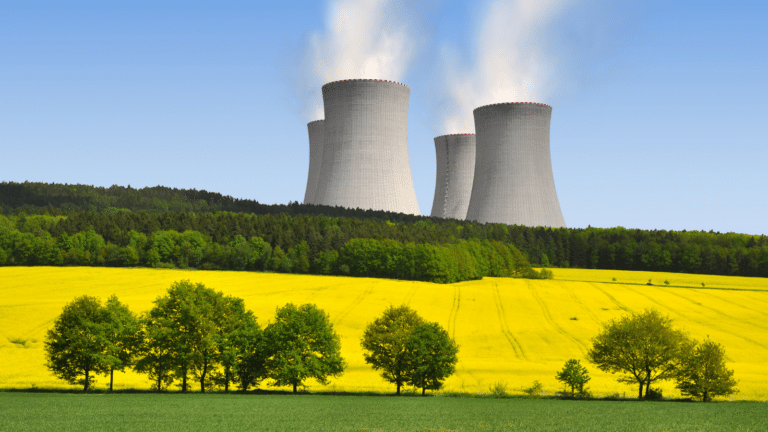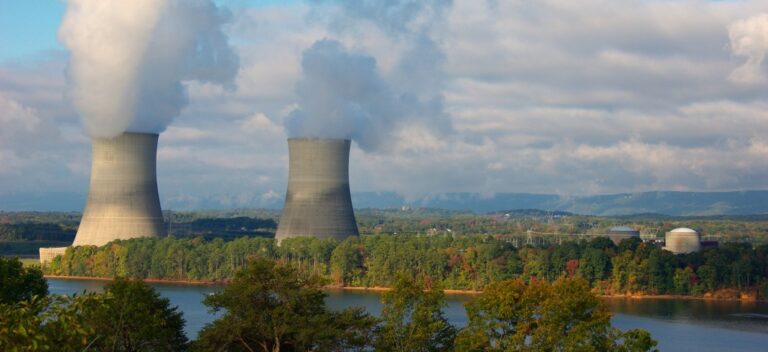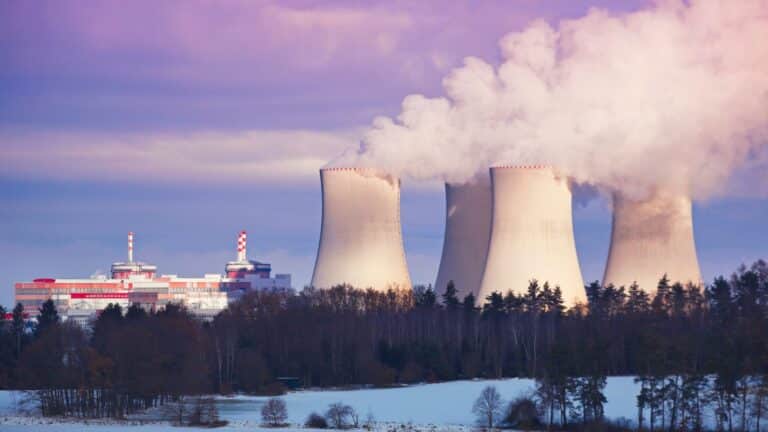Big banks predict catastrophic warming, with profit potential
Morgan Stanley, JPMorgan and an international banking group have quietly concluded that climate change will likely exceed the Paris Agreement's 2 degree
Current Access Level “I” – ID Only: CUID holders, alumni, and approved guests only
Summaries by Matt Bowen, Andrew Evans, Hamna Khan + 1 more • July 03, 2024
On May 9, 2024, Columbia University’s Center on Global Energy Policy hosted a virtual roundtable on nuclear reactor permitting reform in the United States and the environmental reviews that take place as part of their licensing by the US Nuclear Regulatory Commission (NRC). Net zero greenhouse gas emissions scenarios in the United States tend to show a need to generate hundreds of gigawatts of firm, low-carbon energy resources (some of which could be from nuclear reactors), raising the question of whether the US permitting system will be a bottleneck to such efforts, given its track record as a lengthy process.
The roundtable was held just short of a year after passage of the Fiscal Responsibility Act (FRA) of 2023, which amended the National Environmental Policy Act (NEPA) with the intent to speed up federal NEPA reviews.[1] (It was also held a month before Congress passed nuclear-energy-related legislation that specifically directed the NRC to focus on efficient, timely, and predictable environmental reviews.[2]) Participants at the roundtable discussed the potential impacts of the FRA on NRC environmental reviews of new reactor projects. Roundtable participants included individuals from academia, national laboratories, nonprofit organizations, utilities, reactor design companies, and the nuclear industry as well as former staff from the NRC and the White House Council on Environmental Quality (CEQ). This report summarizes the roundtable discussion, which occurred on a not-for-attribution basis under the Chatham House rule.
The roundtable covered questions such as: What challenges are associated with NRC environmental reviews conducted as part of advanced reactor licensing? How does the Fiscal Responsibility Act of 2023 affect those reviews? How do ongoing streamlining initiatives at the NRC fit in with the broader push for NEPA reform in the United States, and how are those initiatives going? What policy options could help address the challenges identified above? Which options in particular could provide the most benefit and why?
Participants discussed how there was a call to reduce paperwork and review delays even when the CEQ issued its first NEPA regulations in 1978.[3] While those CEQ regulations remained largely the same for decades, the agency commenced reexamining them in 2017.[4] Similar to 1978, the goals were to reduce paperwork and delay, to spell out the process more clearly, and to make it easier to understand the regulations. An example of the case for change was the length of time for the development of environmental impact statements (EISs). These were taking about four and a half years on average across the federal government, and the average lengths of those documents exceeded 600 pages, with great variation in the number of pages.[5]
Several of the proposed changes to the CEQ regulations were intended to make the process more efficient. These provisions included presumptive time limits for EISs and environmental assessments (EAs)—two years and one year, respectively—as well as presumptive page limits for EISs depending on their complexity (nominally 150 pages, and 300 pages for extraordinary cases) and for EAs (75 pages).[6] As the time limits and page limits were presumptive, agencies could request to extend the timeframes and number of pages with approval from a senior agency official. Another goal was to avoid duplication and rely more on prior reviews. Some of the proposed regulatory changes by CEQ, including the presumptive time lengths and number of pages for EISs and EAs, were put into statute by the FRA.
Nuclear power plants are licensed by the NRC and require environmental reviews before construction permits can be issued. Participants discussed US permitting reform in the context of how the retirement of fossil fuel plants as part of achieving decarbonization scenarios would increase demand for new non-carbon-emitting technologies, and how advanced nuclear reactors were one option that could help meet that demand.
Roundtable participants discussed how NRC environmental reviews done as part of early site permits (ESPs) and combined licenses (COLs) in recent decades have, in some cases, taken several years and produced thousands of pages—well longer than the new presumptive time limits and page numbers in the FRA. EISs completed by the NRC for ESPs had almost all taken more than two years to complete (with the exception of Georgia’s Vogtle plant), according to participants, with some cases stretching beyond three years; document lengths generally exceeded 1,000 pages.
For COLs the NRC issued for large light water reactor projects, participants said EISs had all taken longer than two years (some took nearly six years) except for projects that had already been issued an ESP (for which an EIS had been done previously). The length of the COL EISs typically stretched over 1,000 pages, with some exceeding 2,000 pages. Participants noted that the NRC staff hours needed for the environmental reviews in some cases ranged from thousands of hours to over 15,000 hours, which would imply costs of millions of dollars to applicants using current NRC hourly staff rates. These costs were in addition to those incurred by applicants in developing the required environmental reports submitted as part of the COL application.
The NRC process also has an opportunity for a formal hearing on environmental issues. As a result, additional time and resources can be required for contending the admissibility of any submitted contentions and, if they are admitted, having the hearing.
Furthermore, participants discussed the extensive nature of the environmental review process under the NRC, which has additional layers compared to environmental reviews conducted by other agencies. NRC regulations by default mandate an EIS for environmental review of new reactors rather than allowing for more efficient approaches such as environmental assessments.
Attendees discussed the possibility that if any of the reactor types under development were to succeed and receive large numbers of orders—which, for example, in the context of micro-reactor deployment could involve hundreds of orders—slower review speeds could cause delays. Potential customers might be looking to order and place into service new nuclear power facilities on fast timelines, in which case the current NRC environmental review process could prove problematic to US deployment and commercial uptake.
Participants discussed initiatives at the NRC concerning environmental reviews. For example, the NRC formed an Environmental Center of Expertise about five years ago, which consolidated different branches within the NRC into one. Participants also discussed favorably the recent Kairos Hermes test reactor project in Oak Ridge, Tennessee, for which the NRC completed an EIS in about two years and at a length of under 300 pages.
Participants discussed legislation under consideration by Congress that calls on the NRC to find ways to facilitate efficient, timely, and predictable reviews of nuclear reactor applications, including through expanded use of categorical exclusions, environmental assessments, and generic environmental impact statements. In that light, participants discussed a variety of potential improvements that could be made to the environmental review process.
One topic was the potential use of a generic environmental impact statement (GEIS) to improve the NRC permitting process for new reactor deployment. Participants discussed some potential benefits of a GEIS, such as limiting issues the NRC staff must handle, which could also help take at least some categories off the table for potential litigation. Some participants opined that the GEIS for existing plants’ license renewal has been a success in terms of promoting greater efficiency.
Participants mentioned, however, that not all issues of the environmental review process can be reviewed generically, and that some issues would likely require additional site-specific review (e.g., those related to endangered species). From that perspective, although a GEIS review process has the potential to review a large number of issues generically, thereby reducing staff/contractor hours and time, certain demanding site-specific issues that need additional analysis could inevitably contribute to delays. However, the overall effort might still be beneficial as compared to the traditional NRC EIS process.
The potential expanded use of environmental assessments instead of EISs was also discussed at the roundtable. EAs would not necessarily reduce the number of issues NRC would have to review, but would reduce the level of analysis required, thereby reducing the environmental review time. For example, for the Kairos Hermes 2 project, which involves the same reactor design at the same location as the Hermes project, the NRC staff has been considering the use of an environmental assessment instead of an EIS. This pathway would need an exemption from existing NRC regulations, which require an EIS for all new reactor projects. If this approach is granted, it could lead to a reduction in review time to perhaps a year (i.e., assuming, on average, a two-year review for an EIS and a one-year review for an EA).
Participants also discussed where updates to regulatory guidance might improve efficiency. They noted that environmental reports applicants submit are currently structured differently than EISs, and better alignment might be helpful. Some participants worried that if the NRC does not change the level of detail required in environmental reports, applicants will still submit 2,000-page reports, meaning that NRC staff will continue to have to review massive submissions. In turn, those thousands of pages will reference thousands of other pages of material, likely limiting how efficient the review can be. Some participants also discussed the idea of using environmental reports submitted by the applicants as draft environmental impact statements for public comment. Some noted that proposed congressional legislation authorizes the NRC to do this.
Finally, participants also discussed how much value there was in the “need for power” and “energy alternatives” analyses in the NRC’s environmental review process, as utilities have the real expertise on these subjects in their specific regions of the United States.
In general, participants agreed that reform efforts underway at the NRC are promising and that a variety of opportunities exist to make more progress in increasing the efficiency of NRC environmental reviews for new reactors. Some participants suggested that additional roundtable discussions could be useful for exploring various issues in greater detail.
[1] Fiscal Responsibility Act of 2023, US Public Law 118-5, 118th Cong. (June 3, 2023), https://www.congress.gov/bill/118th-congress/house-bill/3746.
[2] US Senate Committee on Environment and Public Works, “Senate Sends Capito, Carper, Whitehouse Nuclear Energy Bill to President’s Desk,” press release, June 18, 2024, https://www.epw.senate.gov/public/index.cfm/press-releases-republican?ID=2348A9E4-7B90-40D2-8F32-39D402B2405C.
[3] Council on Environmental Quality, ”Title 40—Protection of Environment, Chapter V—Council On Environmental Quality, National Environmental Policy Act—Regulations, Implementation of Procedural Provisions,” Federal Register 43, no. 230 (Nov. 29, 1978): 55978, https://ceq.doe.gov/docs/laws-regulations/FR-1978-11-29-43-FR-55978-CEQ-NEPA-Regulations-NOFR.pdf
[4] “Executive Order 13807 of August 15, 2017, Establishing Discipline and Accountability in the Environmental Review and Permitting Process for Infrastructure Projects,” Federal Register 82, no. 163 (August 24, 2017): 40464, https://www.govinfo.gov/content/pkg/FR-2017-08-24/pdf/2017-18134.pdf.
[5] Council on Environmental Quality, “Environmental Impact Statement Timelines (2010–2018),”June 12, 2020, https://ceq.doe.gov/docs/nepa-practice/CEQ_EIS_Timeline_Report_2020-6-12.pdf.
[6] Council on Environmental Quality, “Update to the Regulations Implementing the Procedural Provisions of the National Environmental Policy Act,” Federal Register 85, no. 137 (July 16, 2020): 43304, https://www.federalregister.gov/documents/2020/07/16/2020-15179/update-to-the-regulations-implementing-the-procedural-provisions-of-the-national-environmental.



Full report
Summaries by Matt Bowen, Andrew Evans, Hamna Khan + 1 more • July 03, 2024